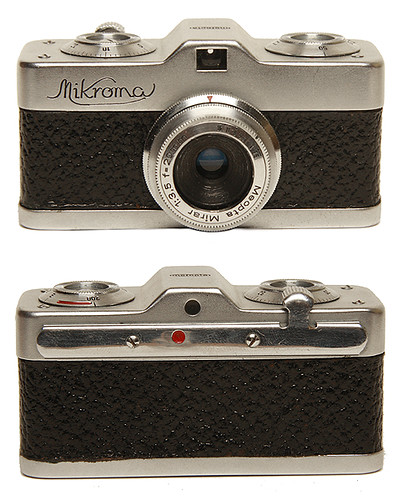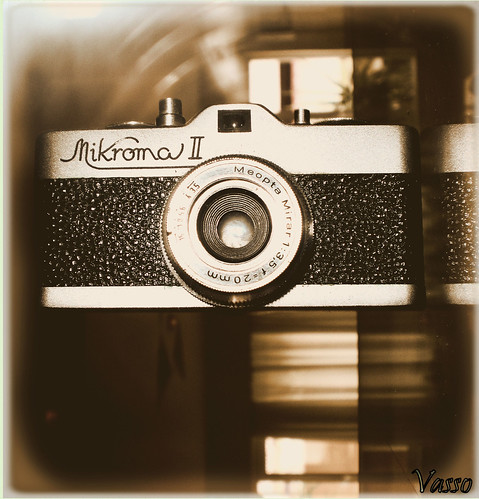Difference between revisions of "Mikroma"
(Some text, a couple of refs and a link.) |
(Added a few details and rephrased. Added ref to manual.) |
||
| Line 5: | Line 5: | ||
|image= http://farm4.static.flickr.com/3372/3215906868_d9c33649eb.jpg | |image= http://farm4.static.flickr.com/3372/3215906868_d9c33649eb.jpg | ||
|image_align= | |image_align= | ||
| − | |image_text= | + | |image_text= Mikroma |
|image_by= Rick Soloway | |image_by= Rick Soloway | ||
|image_rights= wp | |image_rights= wp | ||
| Line 13: | Line 13: | ||
|image= http://farm2.static.flickr.com/1070/4730649639_6f79c57980.jpg | |image= http://farm2.static.flickr.com/1070/4730649639_6f79c57980.jpg | ||
|image_align= | |image_align= | ||
| − | |image_text= | + | |image_text= Mikroma II |
|image_by= Vasso Miliou | |image_by= Vasso Miliou | ||
|image_rights= wp | |image_rights= wp | ||
}} | }} | ||
</div> | </div> | ||
| − | The '''Mikroma''' is a viewfinder camera for | + | The '''Mikroma''' is a tiny viewfinder camera for 16 mm film. It was made from about 1949 by [[Meopta]] in Prerov (then in Czechoslovakia; now the Czech Republic). It measures 75×43×40 mm and weighs 230 g (the Mikroma II).<ref name=Man> |
| + | [http://www.butkus.org/chinon/mikroma/mikroma.htm User's manual for the Mikroma II] (two files; the first is the manual proper, describing the camera controls; the second more of a guide to photography with it), at [http://www.butkus.org/chinon/ Orphan Cameras].</ref> | ||
| − | The | + | Film with perforations on one or both edges can be used, giving exposures of 10.5×14.7 or 11.5×14.7 mm respectively.<ref name=Man></ref> The film must be loaded into a supply cassette. iin the camera it is wound into another cassette on the uptake side. The supply cassette can contain up to 90 cm of film, which is sufficient for 50 exposures. |
| − | + | The camera has a sliding control at the back which advances the film and cocks the shutter when slid to the right, and then releases the shutter when allowed to return.<ref name=EP>[http://www.earlyphotography.co.uk/site/entry_C59.html Mikroma] with combined film advance and shutter release, at [http://www.earlyphotography.co.uk/index.html Early Photography].</ref><ref name=VA>[http://vieilalbum.com/MikromaUS.htm Mikroma] at [http://vieilalbum.com/AccueilUS.htm Le Vieil Album].</ref> | |
| − | The lens is a 20 mm f/3.5 Mirar, a coated triplet. The | + | The lens is a 20 mm f/3.5 Mirar, a coated triplet. It focuses down to 0.6 metre. The shutter is a simple one; a single shutter blade, thrown by a variable spring tension.<ref name=EP></ref> Early cameras have only two marked speeds, 1/50 and 1/100 second, but unmarked, intermediate positions give intermediate speeds.<ref name=EP></ref> Later, the camera was made with more marked speeds: notes on the camera at Le Vieil Album describe an example with speeds 1/25 - 1/200 second, plus 'B'.<ref name=VA></ref> |
| − | + | An improved model, the '''Mikroma II''' from the late '50s, has a conventional shutter release button, threaded for a cable release, and more marked shutter speeds; the user's manual at Orphan Cameras states 1/5 - 1/400 second, plus 'B'. The shutter is synchronised for flash, with a [[PC socket]] on the top plate.<ref name=W>[http://www.westlicht-auction.com/index.php?f=popup&id=238377&_ssl=off#238377 Mikroma II] cameras in blue, brown and green, sold in the [http://www.westlicht-auction.com/index.php?id=232073&acat=232073&_ssl=off November 2011 Westlicht Photographica auction] in Vienna. Note the green camera has a different film advance control. All three have speeds 1/5 - 1/400 second. The lot also includes a Stereo-Mikroma with close-up lens pairs for two ranges, and a Meoscop stereo viewer.</ref> | |
| + | |||
| + | A stereo model of this camera was made. This is focused by the use of auxiliary close-up lens pairs.<ref name=W></ref> | ||
==Notes== | ==Notes== | ||
<references /> | <references /> | ||
| − | |||
| − | |||
| − | |||
| − | |||
[[Category:Subminiature]] [[Category:Czechoslovakia]] [[Category:Meopta]] | [[Category:Subminiature]] [[Category:Czechoslovakia]] [[Category:Meopta]] | ||
Revision as of 10:19, 30 November 2011

|
| Mikroma image by Rick Soloway (Image rights) |

|
| Mikroma II image by Vasso Miliou (Image rights) |
The Mikroma is a tiny viewfinder camera for 16 mm film. It was made from about 1949 by Meopta in Prerov (then in Czechoslovakia; now the Czech Republic). It measures 75×43×40 mm and weighs 230 g (the Mikroma II).[1]
Film with perforations on one or both edges can be used, giving exposures of 10.5×14.7 or 11.5×14.7 mm respectively.[1] The film must be loaded into a supply cassette. iin the camera it is wound into another cassette on the uptake side. The supply cassette can contain up to 90 cm of film, which is sufficient for 50 exposures.
The camera has a sliding control at the back which advances the film and cocks the shutter when slid to the right, and then releases the shutter when allowed to return.[2][3]
The lens is a 20 mm f/3.5 Mirar, a coated triplet. It focuses down to 0.6 metre. The shutter is a simple one; a single shutter blade, thrown by a variable spring tension.[2] Early cameras have only two marked speeds, 1/50 and 1/100 second, but unmarked, intermediate positions give intermediate speeds.[2] Later, the camera was made with more marked speeds: notes on the camera at Le Vieil Album describe an example with speeds 1/25 - 1/200 second, plus 'B'.[3]
An improved model, the Mikroma II from the late '50s, has a conventional shutter release button, threaded for a cable release, and more marked shutter speeds; the user's manual at Orphan Cameras states 1/5 - 1/400 second, plus 'B'. The shutter is synchronised for flash, with a PC socket on the top plate.[4]
A stereo model of this camera was made. This is focused by the use of auxiliary close-up lens pairs.[4]
Notes
- ↑ 1.0 1.1 User's manual for the Mikroma II (two files; the first is the manual proper, describing the camera controls; the second more of a guide to photography with it), at Orphan Cameras.
- ↑ 2.0 2.1 2.2 Mikroma with combined film advance and shutter release, at Early Photography.
- ↑ 3.0 3.1 Mikroma at Le Vieil Album.
- ↑ 4.0 4.1 Mikroma II cameras in blue, brown and green, sold in the November 2011 Westlicht Photographica auction in Vienna. Note the green camera has a different film advance control. All three have speeds 1/5 - 1/400 second. The lot also includes a Stereo-Mikroma with close-up lens pairs for two ranges, and a Meoscop stereo viewer.